Apple iPad 2 Preview
by Anand Lal Shimpi, Brian Klug & Vivek Gowri on March 12, 2011 6:01 AM ESTI remember the speculation that lead up to Apple's iPad launch. The list of things everyone expected the device to do was absurd, and the theories on the architecture behind Apple's first branded SoC was just as fantastic. The simplest answer is sometimes the right one and as Ars Technica's Jon Stokes pointed out, the A4 was nothing more than a hardened ARM Cortex A8 core running at 1GHz in the iPad (and 800MHz in the iPhone 4).

The Cortex A8 is something we've covered extensively here so I won't go into great detail right now. It's a dual-issue, in-order architecture with a 13 stage integer pipeline and a non-pipelined FPU.
When Apple announced the iPad 2, it also briefly announced the A5 SoC. The only detail given? The A5 is a dual-core processor with a GPU that's 9x faster than what's in the A4.

There are only two recent ARM architectures that have multicore support: the ARM11 and the ARM Cortex A9. The A8 doesn't come in a multicore variant. Given how many other SoC vendors are shipping dual-core Cortex A9 SoCs, the A5 was likely no different than NVIDIA's Tegra 2, TI's OMAP 4 or Samsung's Exynos in that regard: armed with a pair of Cortex A9s running at 1GHz. Update: Geekbench reports clock speed at 900MHz. Update 2: Apple confirms 1GHz clock speed on the iPad 2 specs page.
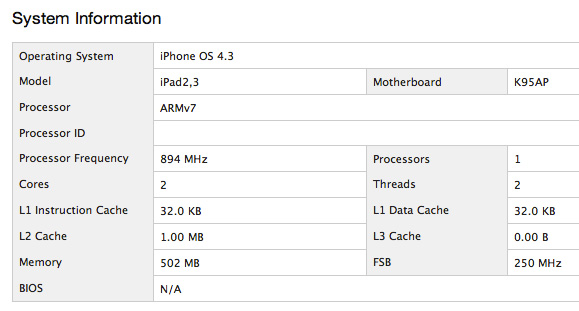
| Architecture Comparison | |||||||
| ARM11 | ARM Cortex A8 | ARM Cortex A9 | Qualcomm Scorpion | ||||
| Issue Width | single-issue | dual-issue | dual-issue | dual-issue | |||
| Pipeline Depth | 8 stages | 13 stages | 9 stages | 13 stages | |||
| Out of Order Execution | N | N | Y | Partial | |||
| FPU | Optional VFPv2 (not-pipelined) | VFPv3 (not-pipelined) | Optional VFPv3-D16 (pipelined) | VFPv3 (pipelined) | |||
| NEON | N/A | Y (64-bit wide) | Optional MPE (64-bit wide) | Y (128-bit wide) | |||
| Process Technology | 90nm | 65nm/45nm | 40nm | 40nm | |||
| Typical Clock Speeds | 412MHz | 600MHz/1GHz | 1GHz | 1GHz | |||
The Cortex A9 is similar to the A8 but with an out-of-order execution engine and a shallower pipeline (9 stages). The result is better-than-A8 performance at the same clock speed. The A9 also adds a fully pipelined FPU.
Now it's unclear what the rest of the A5 SoC looks like, but from the CPU standpoint I think it's safe to say that there are a pair of ARM Cortex A9s in there. We can look at the increase in Geekbench Floating Point scores for some proof:
| Geekbench 2 - Floating Point Performance | ||||
| Apple iPad | Apple iPad 2 | |||
| Overall FP Score | 456 | 915 | ||
| Mandlebrot (single-threaded) | 79.5 Mflops | 279.1 Mflops | ||
| Mandlebrot (multi-threaded) | 79.4 Mflops | 554.7 Mflops | ||
| Dot Product (single-threaded) | 245.7 Mflops | 221.7 Mflops | ||
| Dot Product (multi-threaded) | 247.2 Mflops | 436.8 Mflops | ||
| LU Decomposition (single-threaded) | 54.5 Mflops | 205.4 Mflops | ||
| LU Decomposition (multi-threaded) | 54.8 Mflops | 421.6 Mflops | ||
| Primality Test (single-threaded) | 71.2 Mflops | 177.8 Mflops | ||
| Primality Test (multi-threaded) | 69.3 Mflops | 318.1 Mflops | ||
| Sharpen Image (single-threaded) | 1.51 Mpixels/s | 1.68 Mpixels/s | ||
| Sharpen Image (multi-threaded) | 1.51 Mpixels/s | 3.34 Mpixels/s | ||
| Blur Image (single-threaded) | 760.2 Kpixels/s | 665.5 Kpixels/s | ||
| Blur Image (multi-threaded) | 753.2 Kpixels/s | 1.32 Mpixels/s | ||
Single threaded FPU performance is multiples of what we saw with the original iPad. This sort of an improvement in single-core performance is likely due to the pipelined Cortex A9 FPU. Looking at Linpack we see the same sort of huge improvement:
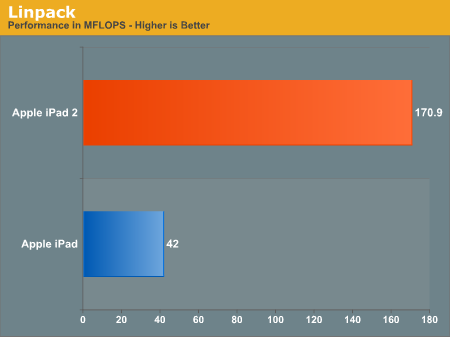
Whether this performance advantage matters is another matter entirely. Although there aren't many FP intensive iPad apps available today, moving to the A5 is all about enabling developers - not playing catch up to software.
Memory size, bandwidth and operating frequencies are all unknowns that I was hoping to find out more about once I put hands on the iPad 2. Geekbench reports the iPad 2 at 512MB of memory, double the original iPad's 256MB. Remember that Apple has to deal with lower profit margins than it'd like with the iPad, but it refuses to cut corners on screen quality so something else has to give.
L2 cache size has also apparently increased from 512KB to 1MB. The L2 cache is shared among both cores and 1MB seems to be the sweet spot this generation.
| Geekbench 2 - Memory Performance | ||||
| Apple iPad | Apple iPad 2 | |||
| Overall Memory Score | 644 | 787 | ||
| Read Sequential (single-threaded scalar) | 340.6 MB/s | 334.2 MB/s | ||
| Write Sequential (single-threaded scalar) | 842.4 MB/s | 1.07 GB/s | ||
| Stdlib Allocate (single-threaded scalar) | 1.74 Mallocs/s | 1.86 Mallocs/s | ||
| Stdlib Write (single-threaded scalar) | 1.20 GB/s | 2.30 GB/s | ||
| Stdlib Copy (single-threaded scalar) | 740.6 MB/s | 522.0 MB/s | ||
Geekbench's memory tests show an improvement in effective bandwidth as well. The biggest improvement is in the stdlib write test which shows a near doubling of bandwidth from 1.2GB/s to 2.3GB/s. Unfortunately this isn't enough data to draw conclusions about bus width or DRAM operating frequency. Given the increases in CPU and GPU performance, an increase in memory bandwidth to go along with the two isn't surprising.
Geekbench shows a healthy increase in integer performance, both in single and multithreaded scenarios. The multithreaded advantage makes sense (two are better than one), but the lead in single threaded tests shows the benefit the A9 can deliver thanks to its shorter pipeline and ability to reorder instructions around stalls.
| Geekbench 2 - Integer Performance | ||||
| Apple iPad | Apple iPad 2 | |||
| Overall FP Score | 365 | 688 | ||
| Blowfish (single-threaded) | 13.9 MB/s | 13.2 MB/s | ||
| Blowfish (multi-threaded) | 14.3 MB/s | 26.1 MB/s | ||
| Text Compression (single-threaded) | 1.23 MB/s | 1.50 MB/s | ||
| Text Compression (multi-threaded) | 1.20 MB/s | 2.82 MB/s | ||
| Text Decompression (single-threaded) | 1.11 MB/s | 2.09 MB/s | ||
| Text Decompression (multi-threaded) | 1.08 MB/s | 3.28 MB/s | ||
| Image Compress (single-threaded) | 3.36 Mpixels/s | 3.79 Mpixels/s | ||
| Image Compress (multi-threaded) | 3.41 Mpixels/s | 7.51 Mpixels/s | ||
| Image Decompress (single-threaded) | 6.02 Mpixels/s | 6.68 Mpixels/s | ||
| Image Decompress (multi-threaded) | 5.98 Mpixels/s | 13.1 Mpixels/s | ||
| Lua (single-threaded) | 172.1 Knodes/s | 273.4 Knodes/s | ||
| Lua (multi-threaded) | 171.9 Knodes/s | 542.9 Knodes/s | ||
On average Geekbench shows a 31% increase in single threaded integer performance over the A4 in the original iPad. NVIDIA told me they saw a 20% increase in instructions executed per clock for the A9 vs. A8 and if we remove the one outlier (text decompression) that's about what we see here as well.
| Geekbench 2 | |||||||
| Overall | Integer | FP | Memory | Stream | |||
| Apple iPad | 448 | 365 | 456 | 644 | 325 | ||
| Apple iPad 2 | 750 | 688 | 915 | 787 | 324 | ||
The increases in integer performance and memory bandwidth are likely what will have the largest impact on your experience. The fact that we're seeing big gains in single as well as multi-threaded workloads means the performance improvement should be universal across all CPU-bound apps.
What does all of this mean for performance in the real world? The iPad 2 is much faster than its predecessor. Let's start with our trusty javascript benchmarks: SunSpider and BrowserMark.
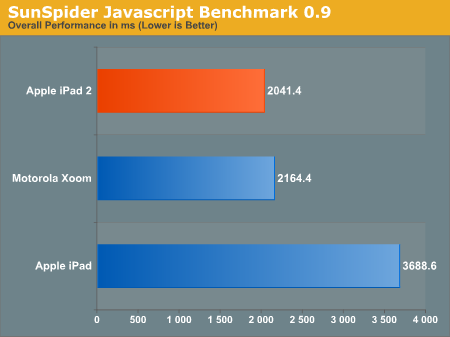
Apple improved the Safari JavaScript engine in iOS 4.3, which right off the bat helped the original iPad become more competitive in this test. Even with both pads running iOS 4.3, the iPad 2 is 80% faster than the original iPad here.
The Motorola Xoom we recently reviewed scored a few percent slower than the iPad 2 in SunSpider as well. Running different OSes and browsers, it's difficult to conclude much when comparing the A5 to Tegra 2.
A bug in BrowserMark kept us from running it for the Xoom review but it's since been fixed. Again we're looking at mostly JavaScript performance here. Rightware modeled its benchmark after the JavaScript frameworks and functions used by websites like Facebook, Amazon and Gmail among others. The results are simply one aspect of web browsing performance, but an important one:

The move from the A4 in the iPad 1 to the A5 in the iPad 2 boosts scores by 47%. More impressive however is just how much faster the Xoom is here. I suspect this has more to do with Google's software optimizations in the Honeycomb browser than hardware, but let's see how these tablets fare in our web page loading tests.
We debuted an early version of our 2011 web page loading tests in the Xoom review. Two things have changed since then: 1) iOS 4.3 came out, and 2) we changed our timing methods to produce more accurate results. It turns out that Honeycomb's browser was stopping our page load timer sooner than iOS', which resulted in some funny numbers when we got to the 4.3/Honeycomb comparison. To ensure accuracy we went back to timing by hand (each test was repeated at least 5 times and we present an average of the results). We also added two more pages to the test suite (Digg and Facebook).

The iPad 2 generally loads web pages faster than the Xoom. On average it's a ~20% increase in performance. I wouldn't say that the improvement is necessarily noticeable when surfing most sites, but it's definitely measurable.
The move to iOS 4.3 really narrowed the gap between the original iPad and the Xoom. In some cases the two actually render pages in the same amount of time, however that's typically for lighter pages that are easy to render. Up the complexity and the Xoom easily distances itself from the original iPad.
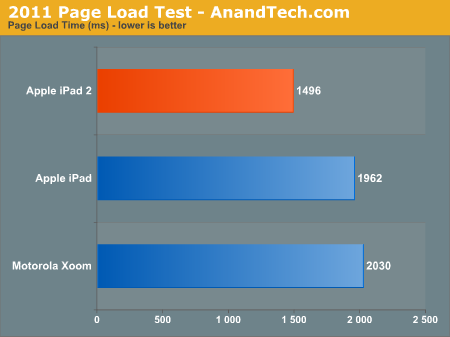
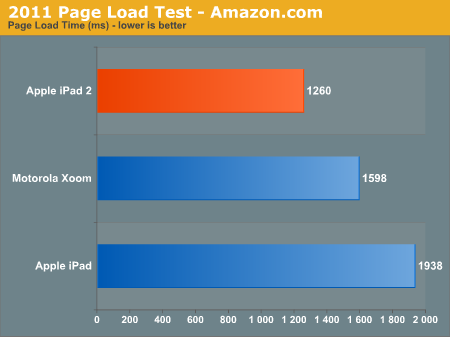
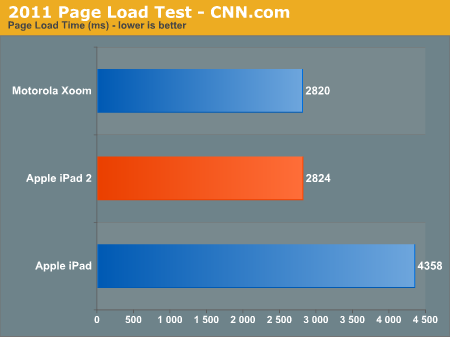

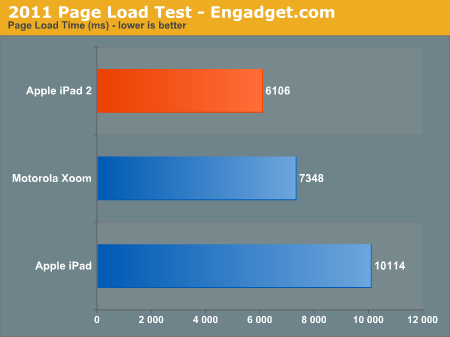

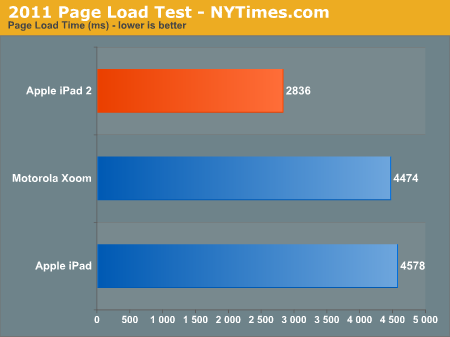
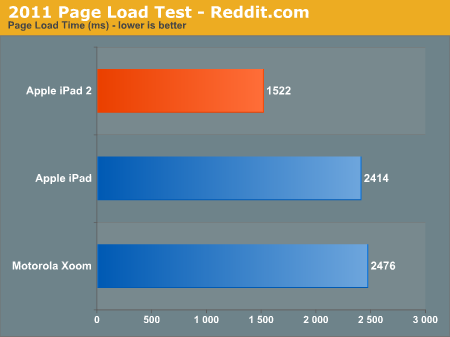
We'll touch on this more in the full review but it's not all about performance when talking about web browsing between the iPad 2 and the Xoom. Although the iPad 2 may have faster render times on average, the Xoom still supports tabbed browsing which definitely has its advantages.










82 Comments
View All Comments
Griswold - Saturday, March 12, 2011 - link
http://www.youtube.com/watch?v=uKPL9CnQVG8&fea...There are reports of light bleeding through the edges of the ipad2. See video above.
Would be cool if you look into this and get to the bottom of it. I dont want to buy one if its a serial flaw.
sean.crees - Saturday, March 12, 2011 - link
I really don't understand the complaints with the camera's. You're never going to get "good" quality photo's from a form factor that flat. Physics just doesn't allow for it with current technology. If your getting a tablet for the camera then your an idiot.It's obvious the only reason the cameras exist at all is for facetime, which they seem perfectly fitted to work with. If you want to take pictures, then buy a DSLR.
Griswold - Saturday, March 12, 2011 - link
Thats nonsense. The iphone4 (and many other smartphones) prove that its possible to produce good quality pictures. Good is not professional level, mind you.However, even if the pictures the iphone4 shoots are not "good" by your standards, there is no reason to sell junk cameras like this in the ipod touch and ipad2 only to come back later this year / next year with a new model that "magically" is capable of doing much better - there is not the slightest doubt it will pan out this way.
They do this on purpose. Thats the beef people have with it.
But yea, I would never use my ipad to take pictures, I use my iphone for it, or my dedicated camera if I have it on me. But Facetime with something better than VGA or a backside shooter with more than a one megapixels isnt too much to ask... again, the issue here is not primarily the lense (though, that will suck too).
solipsism - Saturday, March 12, 2011 - link
The iPhone 4 dimensions are thicker than the iPad 2 and the display on the iPhone 4 are fused in a way that make it thinner. That isn’t to say there is not enough height in the iPad 2 where the cameras are located, but your assumption, in and of itself, is flawed as you did not consider that actual internal room in your presumption.Death666Angel - Saturday, March 12, 2011 - link
Okay, so because Apple decided to make the iPad2 so thin they couldn't even put a halfway decent camera into it, we shouldn't complain? This is exactly why I personally do not want an Apple product (although the iPhone4 does have a great display I miss that on some android phones):with Apple, function follows form, they decided to make the iPad2 thinner (was there a call from the Apple community that the iPad is too thick?), but in return they couldn't (if what you say is true) fit a decent camera into the thing. And the (potential) customer is supposed to shut up about that and not complain.
ltcommanderdata - Saturday, March 12, 2011 - link
The complaint was that the original iPad wasn't comfortable to hold for longer periods of time. Making it thinner, lighter, and curvier was a move to address this.Quoting Anand:
"The iPad 2 is slightly lighter but easier to hold than the previous generation. Laying in bed and reading is probably where the difference becomes most apparent. The gentle curvature running around the edge makes the in-hand feel surprisingly different, as does the considerably thinner profile. I'm actually shocked at how dramatic the difference is."
Yes apparently a compromise had to be made. No doubt Apple actually considers that they optimized on the side of function. ie. the thinner iPad 2 actually functions as an ebook reader now that it's comfortable to hold. Given the typical use case for the iPad will be holding and reading something rather than taking high-quality still pictures, this is probably the best choice for the majority of users.
Juzcallmeneo - Saturday, March 12, 2011 - link
Retina is nice..better than an old LCD. Nothing close to as beautiful as Samsung's Super AMOLED (Plus).I see many people trying to make excuses for the cheap plastic Apple tries to call a camera..but there is no real excuse except that it's just another part of their money making strategies. I know that these devices will never come close to my 7D, but it could at least be slightly better than almost worthless. IMO with cameras this cheap they might as well have not put any on.
I feel that if Nokia can have at least a decent quality camera in a phone several months ago then it should be easy to replicate. (Nokia N8)
The thinness is definitely better for holding, it just scares me how flimsy it might be.
Seurahepo - Sunday, March 13, 2011 - link
> Nothing close to as beautiful as Samsung's Super AMOLED (Plus)I'm a bit puzzled. The Samsung phones I have seen have mostly been disappointing when it comes to the screen quality. The image is fuzzy and it seems almost like there is a template in between the screen and the glass, generating a strange patterns. I assume this to be because of the pentile layout, but I cannot be sure.
Maybe the effect goes away with higher PPI, but currently I can just say that PPI of a traditional RGB layout is not directly comparable to PPI of a Pentile RG BG, which Samsung seems to be using.
> if Nokia can have at least a decent quality camera in a phone several months ago then it should be easy to replicate. (Nokia N8)
Nokia N8 does have a decent camera. The thickness of the camera module of N8 is about double of iPad 2. In optics thickness really matters.
So yeah, it would be easy to replicate by doubling the thickness of the iPad 2 at least where the camera module is. But I fail to see the reasoning. Does iPad 2 really need that to be a good product?
The raison d'être of N8 is to be a phone with real pocket camera like quality, that is not what iPad2 is about, far from it. Therefore it would be quite foolish to try to optimize the camera.
I agree the cameras could be better, but the fantasy about N8 (or even iPhone 4) quality camera for the iPad 2 is a bit crazy.
NCM - Monday, March 14, 2011 - link
Death666Angel (!) writes:"Okay, so because Apple decided to make the iPad2 so thin they couldn't even put a halfway decent camera into it, we shouldn't complain? This is exactly why I personally do not want an Apple product..."
Surely even a moment's reflection would make obvious that a 10" class tablet is wildly unsuited by its form factor for anything but desperation photography. The iPad 2's camera is there for FaceTime video, with still photography enabled only because they can.
Contrast this with the iPhone 4, which is very usable for photography has a surprisingly capable camera.
rish95 - Saturday, March 12, 2011 - link
Well on paper the dual core SGX543MP2 graphics processor is about twice as fast as the Tegra 2's GeForce ULV. I'd like to see how that plays out in real life. I'm worried that iOS's 60 FPS cap may skew the results of some less intensive tests.And since the iPad's screen res is lower than the Xoom, you can expect an even bigger margin.